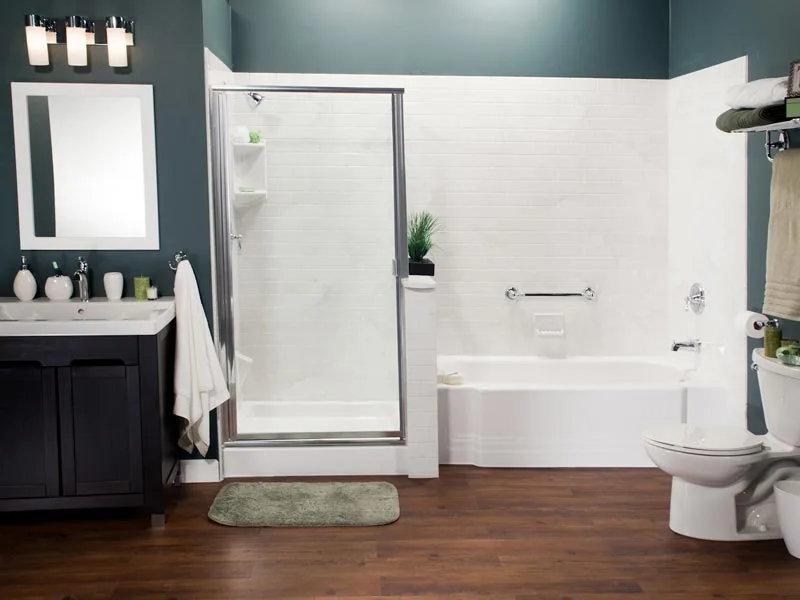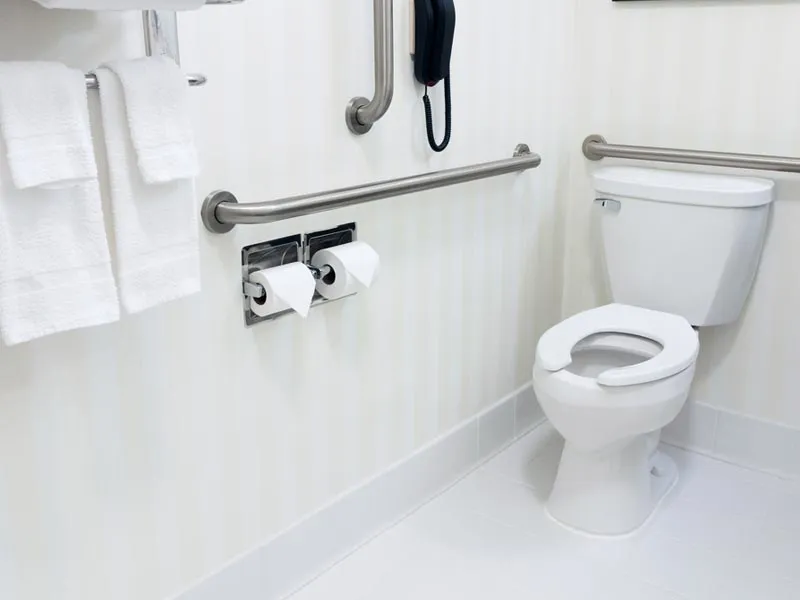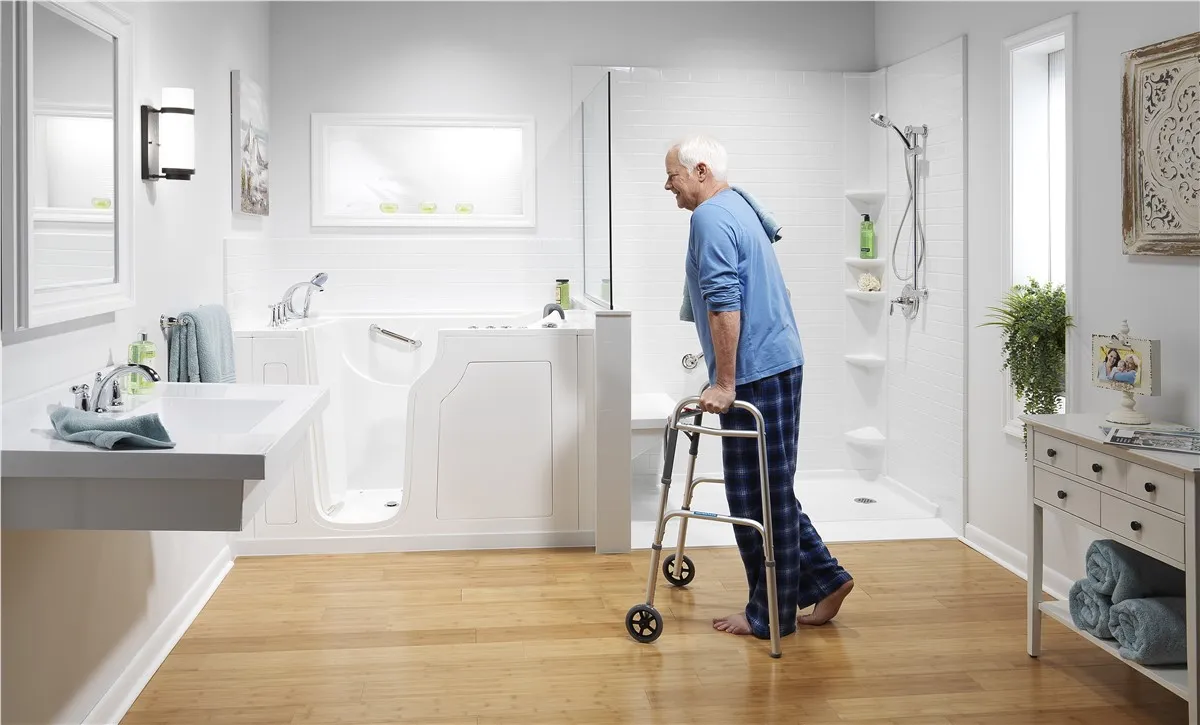Ada Bathroom Remodel Near Me Mineola NY
A comfortable, safe, and fully functional bathroom is essential for everyone, but it’s particularly crucial for individuals with mobility limitations. Accessible bathrooms, built to meet the standards set by the Americans with Disabilities Act (ADA), not only provide a safe environment for those with disabilities but also enhance the living conditions within a household for elderly family members and anyone recovering from injuries.
In this comprehensive guide, we’ll walk you through the intricate process of transforming your bathroom into an ADA-compliant haven. We’ll cover everything from what to expect during the remodeling process, finding the right contractor, important design considerations, and the overall benefits of an ADA bathroom remodel. Whether you’re in Mineola NY, or anywhere else, the information in this post will be invaluable for anyone considering this important home improvement project.
What is an ADA Bathroom Remodel?
- Understanding the Basics: ADA compliance in a bathroom remodel means that the design, feature placement, and overall space adhere to the accessibility guidelines outlined by the ADA. This includes specific requirements for clear floor space, sink and fixture heights, grab bars, and much more. The goal is to provide a space that is not only easily navigable but also maximizes independence and comfort for individuals with a wide range of disabilities.
- How it Differs from a Traditional Remodel: An ADA-compliant remodel is a specialized form of renovation that focuses on accessibility. Unlike a traditional bathroom remodel, an ADA-compliant project requires strict adherence to regulations that support access for individuals with mobility challenges. This involves altering the current layout and ensuring all features meet a set of specific standards, ensuring a safe and user-friendly environment.
- Benefits of an ADA Bathroom for Those with Mobility Limitations: An ADA bathroom provides a plethora of benefits for its users. It ensures the ability to use the facilities independently, helping to maintain a sense of autonomy and privacy. Additionally, it can aid in the prevention of falls and injuries, which are common and particularly dangerous for those with limited mobility.
Understanding Your Needs and Setting Goals
Before any demolition begins, it’s essential to assess your current bathroom’s layout and features. Document areas where you may encounter difficulty or where the space could be better utilized.
- Assessing Current Bathroom Layout and Features: Take note of the size of your bathroom, existing fixtures, and the space between them. The accessibility of these elements will influence the design and where changes need to be made.
- Identifying Accessibility Needs or Challenges: Whether it’s navigating the room with a wheelchair, reaching for items from a standing or seated position, or using the toilet or shower comfortably, every need is unique. Speak with users who have direct experience with the current bathroom layout to gain insights into potential challenges.
- Setting Remodeling Goals and Budget: Your goals for the remodel should be SMART—Specific, Measurable, Achievable, Relevant, and Time-bound. Pinpoint what you aim to accomplish and decide on a budget that reflects your priorities and financial boundaries.

What to Expect During an ADA Bathroom Remodel
- The Phases of an ADA Bathroom Remodel: An ADA remodel involves several distinct phases to ensure that the final bathroom is compliant and meets the specific needs of its user.
- Initial Consultation and Assessment of Needs: This is the starting point where you and your contractor discuss your specific accessibility requirements. The contractor may suggest an occupational therapist or ADA specialist to help determine the best design for your needs.
- Design Phase and Fixture Selection: This phase is where your preferences and requirements are translated into a functional design. Fixtures and features that are both ADA-compliant and suit your aesthetic choices will be selected.
- Permits and Approvals: Getting the proper permits for an ADA remodel is crucial. This process varies by location and it’s essential to be aware of the local regulations and requirements to prevent any delays.
- Construction and Installation: The construction phase involves building out the approved design and installing the necessary features. It’s quite intricate and can be slightly more complex than a typical remodel due to the precision required for ADA compliance.
- Final Inspection and Handover: A final inspection is conducted to ensure everything is in place and meets ADA regulations. Once approved, your contractor will handover the project to you.
- Timelines and Potential Disruptions: An ADA remodel, depending on the scale, can take a substantial amount of time. It’s important to expect some level of disruption and plan accordingly, especially if the bathroom is the only one in the home.
Incorporating ADA Features into Design
An ADA-compliant bathroom can be as visually striking as it is functional. Understanding what’s needed and where to place these features is crucial.
- Overview of ADA Requirements for Bathrooms: Familiarize yourself with ADA guidelines, especially those that pertain to bathrooms. The ADA Standards for Accessible Design provide a comprehensive overview of what’s required for a bathroom to be considered accessible.
- Recommended Features for an ADA Compliant Bathroom: From the clearance around fixtures to the height of vanities and the type of hardware used, there are specifics that you should consider. These features are not just law, but they enhance usability for everyone.
- Creative Design Ideas for a Visually Appealing Space: Don’t shy away from creativity. Use color, texture, and materials to create a bathroom that feels both personal and inviting. Mosaics, contrasting tiles, and expertly chosen lighting can all enhance the aesthetic appeal without compromising accessibility.
Choosing Functional Fixtures and Features
Selecting the right fixtures and features is perhaps one of the most critical elements of an ADA-compliant bathroom.
- Wheelchair Accessible Sinks, Toilets, and Showers: These fixtures often form the focal point of an ADA remodel. Wall-mounted sinks, toilets with appropriate seat heights, and roll-in showers are just a few examples of what may be necessary.
- Grab Bars, Handrails, and Non-Slip Flooring: Safety is paramount in an ADA bathroom. Strategically placed grab bars and handrails, along with non-slip flooring, protect against falls and provide peace of mind.
- Benefits of a Curb Less Shower for Easy Entry: A curbless shower provides both accessibility and a modern aesthetic. They’re easy to enter and can accommodate various needs with adaptable showerheads and seating options.

Maximizing Space and Storage
Ensuring that every inch of space is used effectively is a key component of a successful ADA remodel.
- Space-Saving and Adjustable Features: Many fixtures and features come with space-saving designs or adjustable features that can make a significant difference, especially in smaller bathrooms.
- Incorporating Storage Solutions for Accessibility: Storage in an ADA bathroom should be easily reachable from both a seated and standing position. Consider open shelving, pull-out drawers, and other innovative storage solutions to keep the space organized and user-friendly.
- Organization and Clutter-Free Design: An organized space is essential to maintaining accessibility. Think about storage placement and use to keep clutter to a minimum and maintain the room’s functionality.
Ensuring Safety and Convenience
Our attention to details continues with the safety and convenience features necessary in an ADA-compliant bathroom.
- Lighting and Ventilation Considerations: A well-lit space with natural and artificial lighting is important for safety and ambiance. Proper ventilation helps ensure the longevity of the materials used in your remodel.
- Installation of Accessible Switches and Outlets: Consider the placement of switches and outlets to make them accessible from various points in the room, without the need for unnecessary reaching or bending.
- Incorporating Technology and Smart Home Features: Smart home technology can enhance the usability of an ADA-compliant bathroom. Features like voice-activated lights and temperature controls can add an extra layer of convenience.
Finding the Right Contractor for Your ADA Bathroom Remodel Near Me
- The Significance of a Quality Contractor: Selecting the right contractor for your ADA remodel can make or break the project. A skilled, experienced contractor can ensure that the remodel is completed to the highest standards and within the expected timeframe and budget.
- Research and Comparison: Start by researching local contractors with experience in ADA renovations. Look for customer reviews and ask for references. Ensure their portfolio includes successful ADA projects.
- The Initial Consultation: The first meeting with a potential contractor is a critical stage where you can gauge their understanding of ADA requirements and your specific needs. Prepare a list of questions and take note of how well they address your concerns.
- Checking Credentials and References: Always verify the contractor’s licensing and insurance. Check with previous clients to get a sense of the contractor’s work ethic and the success of past projects.
- Importance of Contractor Experience and Expertise: A contractor experienced in ADA remodels will be familiar with the necessary adjustments and customizations required for an accessible bathroom — from the layout to the nuanced requirements of fixtures and fittings.

Cost Consideration and Budgeting for Your ADA Bathroom Remodel
Managing the expenses related to an ADA-compliant bathroom remodeling project requires careful planning and consideration. Understanding where costs are likely to arise and strategizing on how to mitigate these without compromising on quality or compliance is crucial.
Key Factors Affecting Cost
Several factors influence the overall cost of an ADA bathroom remodel. These include the size of the bathroom, the extent of the modifications needed, the cost of labor in your area, and the price of the materials chosen. High-quality, durable materials and fixtures that meet ADA standards may carry a higher upfront cost but can offer better longevity and usability.
Budgeting Tips
- Prioritize Needs Over Wants: Focus on essential modifications that will ensure accessibility and compliance before considering aesthetic upgrades.
- Comparison Shop: Obtain quotes from multiple suppliers and contractors to ensure competitive pricing for materials and labor.
- Consider Long-Term Savings: Investments in energy-efficient lighting and water-saving fixtures can reduce utility costs over time, offsetting some of the initial expenses.
- Seek Financial Assistance: Look for grants, subsidies, or loans specifically designed for making homes more accessible. Some government and non-profit organizations offer financial aid for ADA compliance projects.
How to Influence Costs in Your Favor
- DIY What You Can: Certain aspects of the remodel, like painting or the installation of simple fixtures, can be done by yourself to save on labor costs.
- Reuse and Adapt: Whenever possible, adapt existing features to meet ADA requirements instead of replacing them entirely. For example, installing an adjustable showerhead can be more cost-effective than a complete overhaul of the shower area.
- Negotiate with Contractors: Don’t hesitate to discuss costs with your contractor. They can often suggest alternative materials or solutions that achieve the same functional goals at a lower cost.
- Phase Your Project: If budget constraints are significant, consider completing your remodel in stages. Prioritize changes that impact usability and compliance first, with cosmetic upgrades following as funds allow.
Taking a strategic approach to budgeting and cost management can make an ADA bathroom remodel more financially manageable, ensuring you achieve a space that is both compliant and comfortable without overspending.
Delving into Effective Project Scheduling for Your ADA Bathroom Renovation
- Crafting a Detailed Timeline: The first step in orchestrating a successful ADA bathroom remodel near you in Mineola, NY, involves mapping out a detailed timeline. Begin with pinpointing your desired kickoff and anticipated completion dates. It’s important to factor in the seasonal dynamics and local events of Mineola, NY, as these can influence both the timeline and logistics of your project.
- Engaging with Experienced Contractors: Consultation with a seasoned contractor who specializes in ADA bathroom renovations is vital. Leveraging their wealth of experience and understanding of local regulations, your contractor can offer an accurate estimate of how long your project will take. This is the perfect time to search for a reputable “Ada Bathroom Remodel Near Me in Mineola, NY”, ensuring that you partner with a professional who can bring your vision to life while adhering to ADA standards.
- Incorporating Flexibility for Unanticipated Hurdles: Amidst the excitement of planning your renovation, it’s crucial to prepare for the unexpected. Allocating buffer time within your schedule caters to unforeseen circumstances, such as delivery delays or the need for modifications. This foresight ensures that such bumps along the road do not derail the overall timeline of your project.
- Synchronizing Schedules: A pivotal aspect of smooth project execution is ensuring that the availability of your contractor and any subcontractors neatly aligns with your proposed timeline. This step includes tackling administrative tasks, such as securing any permits required for the renovation. In doing so, you’ll avoid potential start date postponements and ensure all parties are ready to forge ahead as planned.
- Keeping Household Members in the Loop: Transparency is key. Maintaining open lines of communication with everyone in your residence ensures that the renovation schedule’s impact on daily life is managed and understood. This not only prepares them for the temporary inconveniences but also fosters an atmosphere of cooperation and excitement about the improvements being made.
- Proactively Monitoring Your Project’s Advancement: Active involvement in your renovation project is indispensable. Regular updates and check-ins with your contractor facilitate the swift resolution of any emerging issues, keeping the renovation on its intended course.
By engaging with these strategies, you empower yourself to create a detailed and realistic schedule for your bathroom renovation. This meticulous approach not only minimizes potential stress but also significantly enhances the project’s efficiency.

Final Touches and Finishing
The final stage of your ADA bathroom remodel is crucial for pulling the entire project together.
- Choosing ADA Compliant Accessories and Décor: Accessories and décor can further emphasize the accessibility and appeal of your new bathroom. Choose items that meet ADA standards and complement your design.
- Importance of a Thorough Final Inspection: Once the remodel is complete, a thorough inspection helps to ensure all ADA guidelines are fully met. This step is the last safeguard in the process and should not be overlooked.
- Tips for Maintaining an ADA Compliant Bathroom: Finally, maintain your new bathroom with regular upkeep. Stay organized, address any issues promptly, and consider regular check-ups to ensure everything remains in the best possible condition.
The Conclusion
Your choice to renovate in compliance with ADA standards is about far more than following the law. It’s about creating a space that’s truly inclusive and safe for anyone who enters it. With this guide, you’re well on your way to not only understanding how to execute this significant change, but also on the path to realizing the fulfilling impact it can have on your home and the daily life of those who inhabit it.
For more detailed planning and specific ADA requirements, consulting with a professional remodeling service or ADA specialist could provide invaluable insight. With a clear vision, proper preparation, and the right experts, your ADA-compliant bathroom remodel will not only meet your expectations but surpass them in every way.
If you’re looking for an expert ADA bathroom contractor near you in Mineola, NY, start your search with a clear understanding of the requirements and a list of reputable professionals. Remember, an accessible bathroom is an asset that provides value both for present comfort and future needs.











